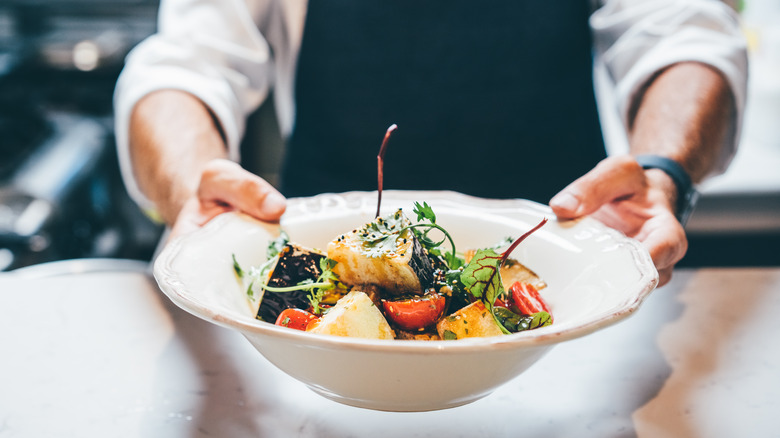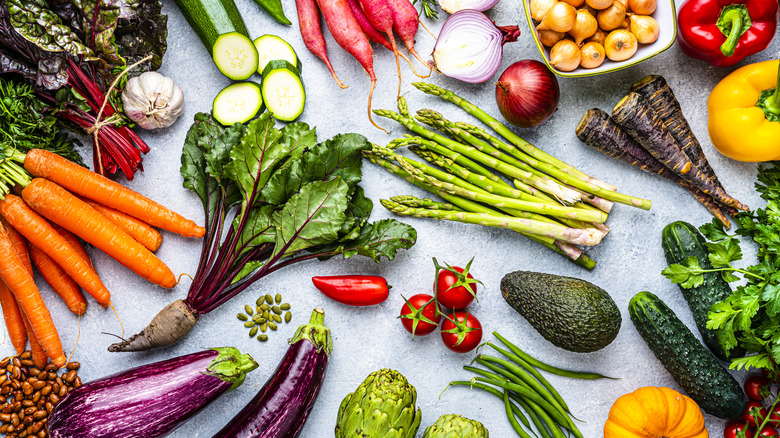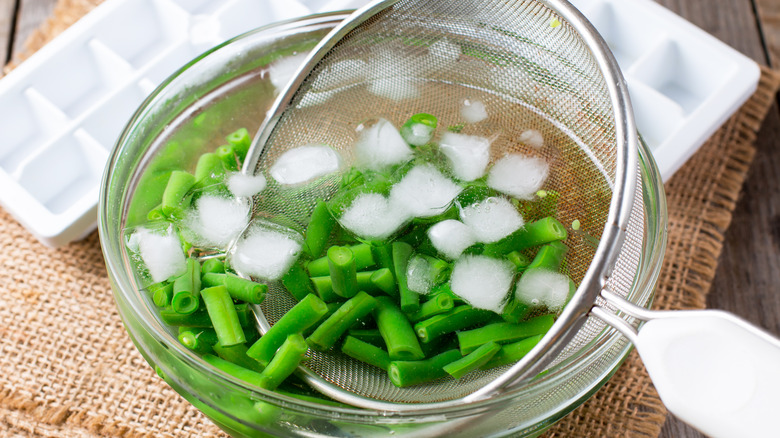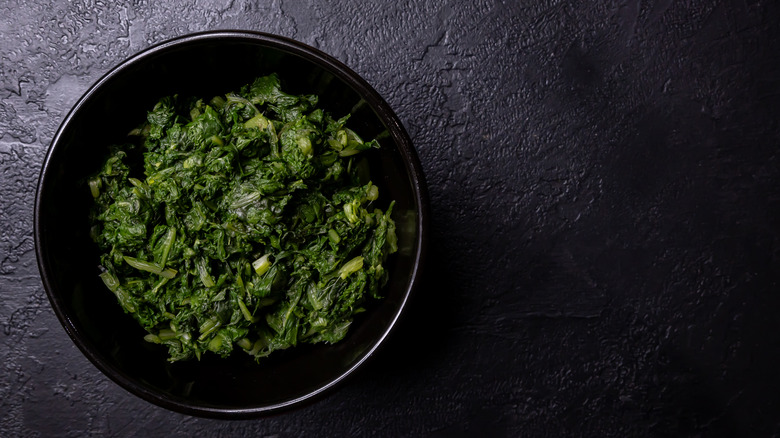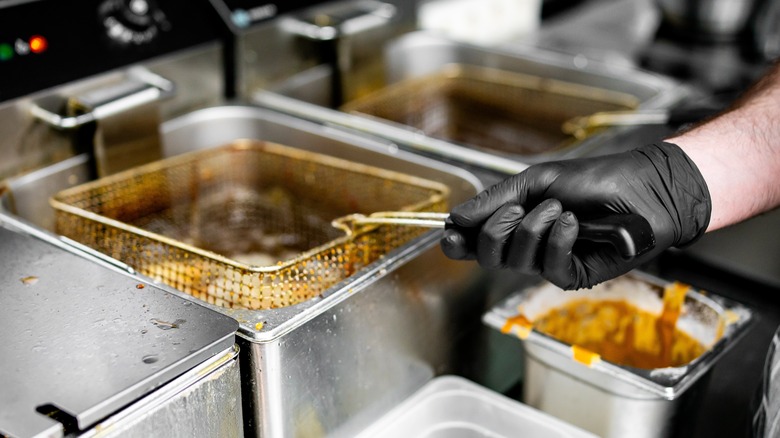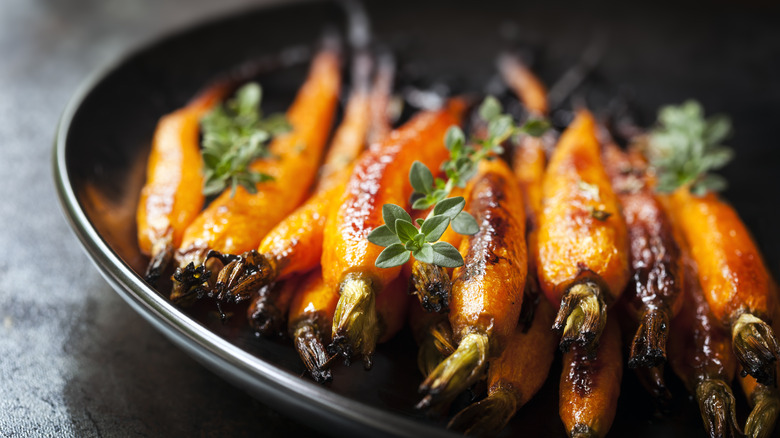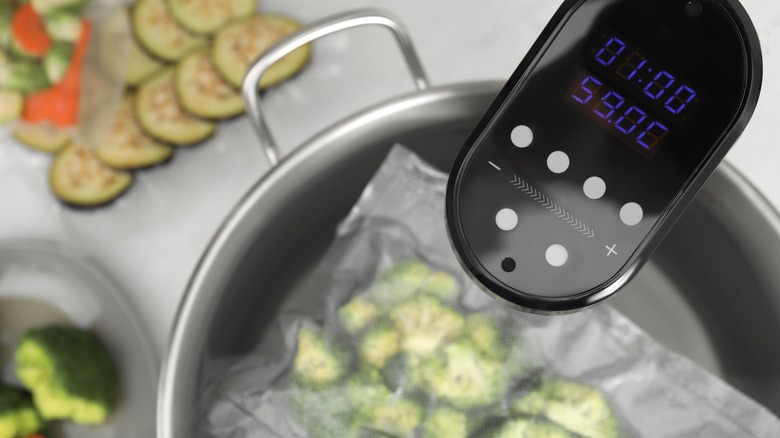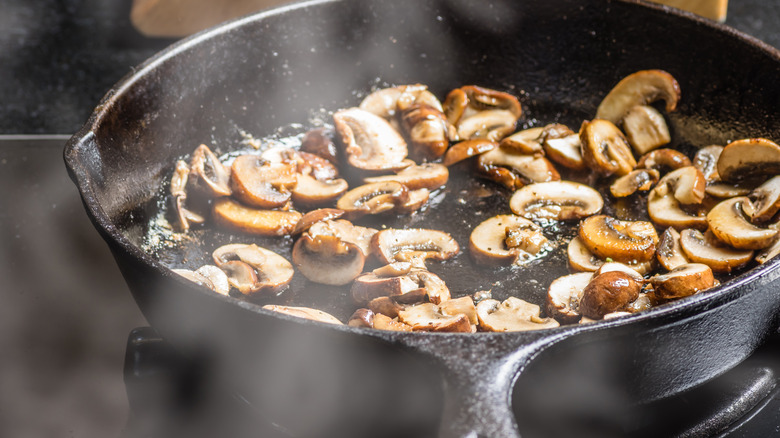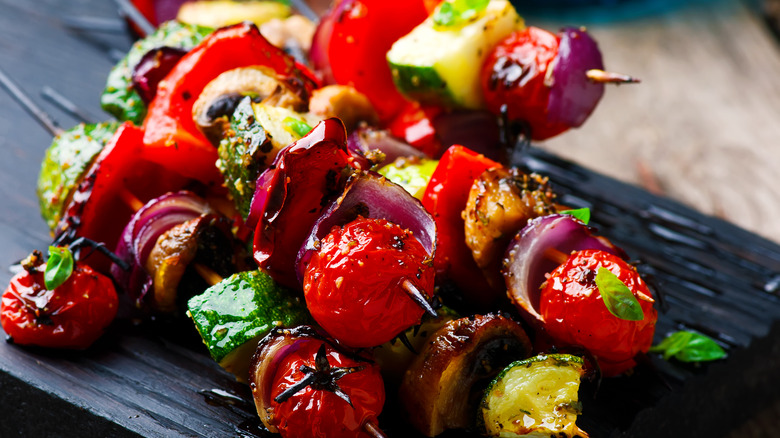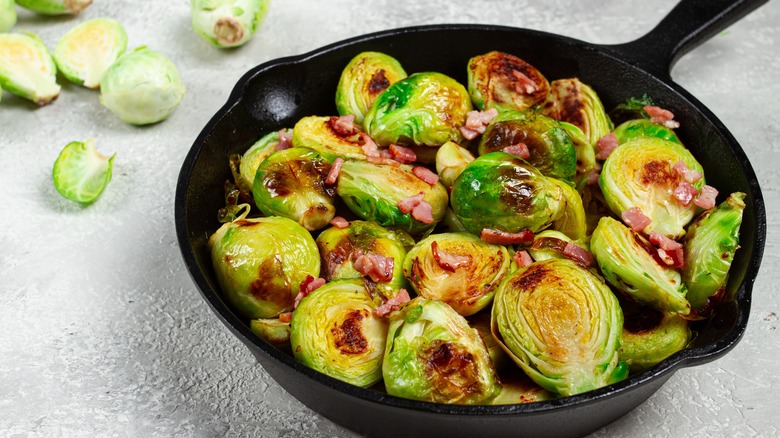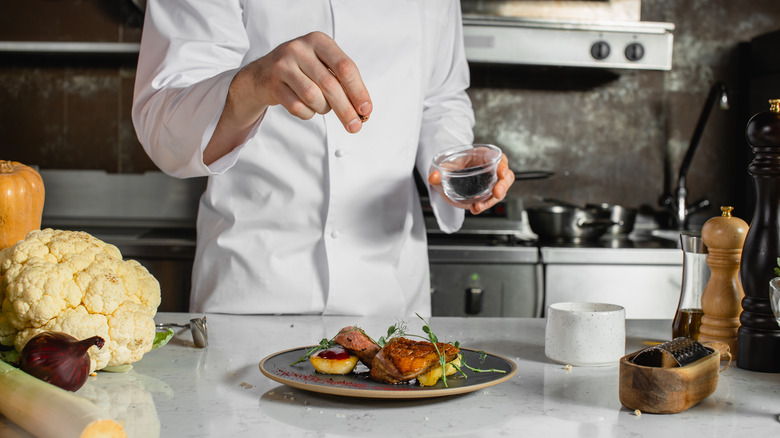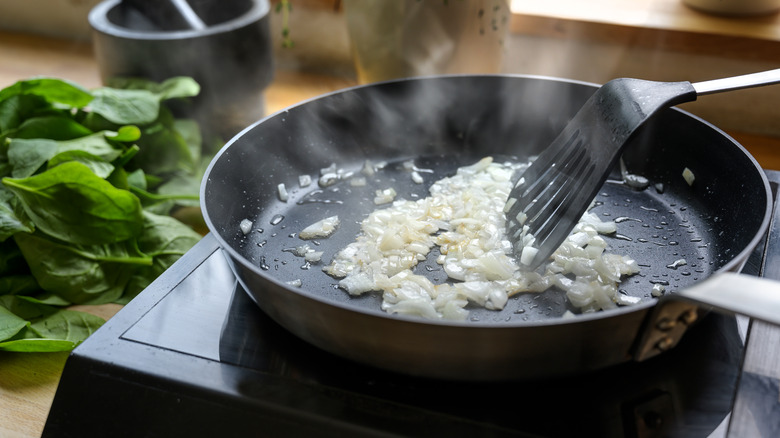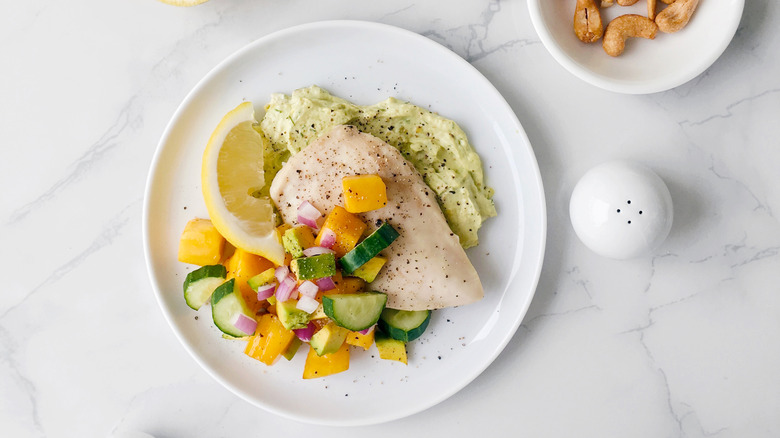Why Vegetables Always Taste Better At A Restaurant Vs At Home
Among the foods that diners most commonly cite as tasting better at a restaurant than when they are prepared at home are vegetables. While we all know we should be eating more of them, most of the time they turn out uninspiring at best. Even the freshest vegetables can easily become mushy and bland if they aren't handled with a little know-how and tender loving care. So what are chefs doing differently behind the scenes that makes their vegetables turn out so succulent, vibrant, and flavorful?
I'll let you in on a secret: Chefs may seem like magicians, but we aren't. We just have some knowledge, experience, and tools that the average home cook doesn't. In my nearly two decades as a professional, nothing excited me more than freshly picked, seasonal vegetables. The possibilities for transforming them into masterpieces were endless. I knew that when I presented these vegetables to my dinner guests, they would look at me in awe when they discovered they actually enjoyed a vegetable they usually disliked because they hadn't had them prepared properly.
Unlike some chefs, who guard their recipes and trade secrets like they are FBI classified documents, I readily share my tips and tricks with anyone who asks. I do so because we should all eat well, regardless of if we are dining out or having a quiet dinner at home. Read on to discover some of the ways that restaurant chefs create the most mouthwatering vegetable dishes.
They have access to unique vegetables
While farmers markets and specialty grocers selling fresh, organic vegetables are more common than ever, the selection of different types of produce and heirloom varieties of commonly consumed items, like tomatoes and carrots, is less frequent. This is where restaurants have an edge over most home cooks. Many restaurants have access to specialty purveyors or suppliers for unique vegetables with which they can stock their kitchens. Some restaurants even have gardens, where they can grow produce to meet their needs.
Restaurants also use vegetables that are often overlooked by home cooks, either because they have never heard of them or do not know how to process them. Some of the more obscure examples of these include fennel, parsnips, artichokes, and broccoli rabe, as well as peppery greens, like watercress. If you are interested in upgrading your vegetable game, I recommend seeking out some of these more unusual vegetables and learning how to cook them. While they may take some additional time and effort to prepare, it will be well worth it in terms of expanding your vegetable repertoire.
Chefs know how to cut and prepare vegetables properly
When it comes to one of the things chefs are adept at, it's knife skills. Learning how to wield a sharp chef's knife and prepare foods safely and correctly is a skill that can make all the difference in the world when cooking vegetables. Contrary to popular belief, not every vegetable should be cut the same way. Some require special knives, like a paring knife, while others need to be handled with care, either because of delicate skins or because they are round, which can make them unruly to handle. Still others may benefit from a particular type of cut depending on the recipe, like a julienne for stir-fries, a batonnet for french fries, or a brunoise for soups.
Then there are certain vegetables that may taste better if prepared one way versus another. Carrots, for example, will become sweeter when they are grated versus chopped, while high-moisture vegetables, like zucchini or eggplant, will benefit from advanced salting to draw out excess moisture that can give them a soggy texture when cooked.
Lastly, chefs recognize that timing is everything when it comes to cutting and preparing vegetables. Unless properly stored, pre-cut vegetables can lose freshness and become wilted if they are cut too soon. A great hack is to soak them in an ice water bath, which can help keep their colors vibrant and their texture crisp and firm.
They blanch vegetables to preserve color
Speaking of preserving the color of vegetables, one trick that restaurants regularly employ to ensure that verdant veggies stay that color, is to blanch them. Blanching is a process during which fresh vegetables are submerged into a pot of salted, boiling water for a minute or two, before being transferred to a bowl of ice water. This action, known as shocking the vegetables, arrests the cooking process, which prevents them from becoming mushy and helps them to retain that snappy, al dente texture.
Blanching has other benefits as well. It can help prevent nutrient loss, especially when you plan to freeze vegetables. It also works to dislodge excess grit and any critters from fresh vegetables that tend to cling to dirt, like broccoli and cauliflower. For recipes using vegetables that may take different amounts of time to cook, blanching the denser ones can help expedite their cooking, ensuring that all of them are finished simultaneously. Lastly, blanching is one of the best ways to eliminate the skins of produce, like tomatoes or peppers, where they may create an unpleasant mouthfeel in a recipe.
Chefs don't overcook vegetables
Perhaps the greatest mistake when cooking vegetables that many home cooks are guilty of is overcooking them. This results in a loss of nutrients, muted color, and a mushy texture, which in some cases renders a perfectly delicious vegetable completely inedible. While there are some exceptions to this rule, such as potatoes intended for mashing or difficult to digest cruciferous vegetables, generally speaking, less is more when it comes to cooking vegetables. The key is to aim for vegetables that are no longer crunchy, yet still al dente.
One of the easiest ways to avoid overcooking vegetables is by not boiling them. Opt instead for blanching, where the vegetables will be shocked in ice water before they get to the point of no return; or choose another cooking method, such as grilling, roasting, frying, or sautéeing, where you have a little more control over their doneness.
If you have overcooked your vegetables, there are some ways to salvage them. You can repurpose these veggies by whizzing them together with chicken or vegetable stock, spices, and some caramelized onions to create a luscious soup. Alternatively, you can always toss them into some eggs to create a breakfast frittata or casserole.
They have access to commercial fryers
One common way that restaurants prepare vegetables is lightly battered and fried. Fried vegetables retain an al dente texture that is surrounded by a golden brown, crunchy batter. Frying can also transform the texture of vegetables that might otherwise be an acquired taste for some, such as okra, which can be slimy when boiled or sautéed, but becomes firm when fried. For this reason, most restaurants have commercial fryers.
If you have ever tried to fry something at home using a pot filled with oil, you are familiar with the inconvenience and aggravation of this process. Depending on whether you have a gas or electric stove, maintaining the proper temperature to fry something to perfection is challenging. What's even more aggravating is figuring out how to dispose of that used oil, which cannot be poured down your sink and must be transferred to a container before it can be discarded in the trash.
Though you can purchase home fryers, they take up a lot of space and are not particularly effective at maintaining the proper temperature. And, while air fryers are great for some applications, they are not intended for use with wet batters, as these can gunk up the frying basket, preventing the air from circulating and resulting in soggy, undercooked vegetables. For this reason, restaurants have an advantage when it comes to frying up vegetables.
Restaurant chefs roast them at high temperatures
While grilling, sautéeing, blanching, and stir-frying vegetables are all great ways of preparing them, one of the most effective ways of infusing them with flavor and giving them a perfect toothsome texture without overcooking them is by roasting them. During the roasting process, vegetables undergo the Maillard reaction, during which the natural sugars and amino acids are transformed, becoming crisp and develop a rich, umami-forward aroma and flavor. This reaction is best achieved using high-heat cooking methods, like roasting.
That said, the key here is high-heat. The ideal temperature to roast veggies is around 425 degrees F. Restaurants know this, and they employ this cooking method frequently with vegetables of all kinds. While roasting isn't a difficult method of cooking food, it does require some focus and attention, otherwise the vegetables can quickly go from brilliant to burnt.
When roasting vegetables, they should be cut into uniform-sized pieces and distributed evenly in a single layer on a baking sheet. Dense root vegetables will take longer to cook than others, so they may need to be roasted in stages. I like to season vegetables liberally with olive oil and sprinkle them with salt, pepper, and a variety of dried herbs and spices. During the roasting process, I stir vegetables frequently to ensure they roast evenly.
Sous vide units are used in restaurants
Originally seen in restaurants in France in the 1970s, sous vide is a method of slow-cooking, during which foods are vacuum-sealed before being submerged into an immersion circulator. These foods are cooked low-and-slow until they achieve the perfect doneness. They are usually finished by grilling, pan-searing, or otherwise heating them, adding some crispness and seasonings. While sous vide units are now available for home cooks to purchase, they are expensive and more commonly found in restaurants that have the space and know-how to accommodate this unique culinary technique.
While many foods can benefit from being cooked using a sous vide unit, vegetables are particularly well-suited for this type of culinary method. Because they are vacuum-sealed, the juices of the vegetables get trapped inside the plastic bag, helping to amplify their natural flavors. They also retain their vibrant colors, which can easily get lost in other cooking methods. Lastly, they can be cooked to the perfect al dente throughout, ensuring that every bite is equally flavorful and toothsome.
They cook them in small batches
One vegetable cooking faux pas that will inevitably result in overcooked, mushy veggies is overcrowding the pan. While it may be tempting to cook up a big batch of vegetables all at once, this may be ill-advised. Rather than the vegetables getting heated evenly and quickly, reaching the temperature necessary for the Maillard reaction to begin, their natural moisture will get released, slowing the heating process and resulting in steamed, soggy veggies.
The key is to cook vegetables in batches, allowing plenty of space around them for each to get evenly heated. Restaurant chefs know this and will usually cook vegetables to order, or will use larger pans that can fit more at a time. These commercial pans are ideally-suited to restaurant kitchens because they are designed for high-heat cooking. Commercial ranges found at restaurants emit more energy than standard home units do (on average 25,000-30,000 BTUs as opposed to 12,000-15,000 BTUs), which means they can cook food faster and hotter. And, while you may be able to purchase these larger pans, most home kitchens are not designed to accommodate them.
Chefs infuse vegetables with unique seasoning
No matter how flavorful fresh vegetables are, they need some seasonings to amplify their inherent taste. Chefs know this and use myriad dried herbs and spices, beyond salt and pepper, to completely transform vegetables into something magical. While they may be adept at mixing and matching individual spices, knowing precisely which go together and which do not, they also rely on spice blends, including exotic ones, like ras el hanout or garam masala, and classics, like Old Bay. Each of these can balance out the inherent sweet, bitter, or umami components of a given vegetable, when used in just the right amount and at the right time during the cooking process.
For a different approach, chefs will often marinate vegetables. There are two schools of thought when it comes to using a marinade on veggies. The first recommends marinating them before cooking. This is particularly useful for dense root vegetables, where the marinade will not be as detrimental to their final texture. They can also be marinated after they have been cooked, which is particularly useful for softer vegetables and ones intended for use on salads. This process, known as post-marinating, enables the natural sugars within the vegetables to caramelize before they are infused with added flavor, preserving their texture and giving them more complexity.
They aren't afraid of fat
Professionals in the food industry know one thing to be true — fat equals flavor. There are a number of reasons that chefs lean on fat when it comes to cooking vegetables. At its most basic, fat soluble molecules within vegetables cannot be detected without the presence of fat. They will only be released when fat has been incorporated, after which their flavor and aroma can make their way to your taste and olfactory receptors.
But that's not the only place where fat can enhance vegetables, it also improves their texture. First, fat is a fabulous conductor of heat, helping your veggies cook more rapidly. Secondly, the unique viscosity of fat can envelop vegetables, giving them a more luxurious and satiating mouthfeel.
When it comes to the types of fat to use, it can be helpful to understand the ways in which certain vegetables will evolve in terms of taste and texture as they cook. For example, some vegetables develop an intense nutty flavor when they are cooked. I like to play off of this by using a dash of sesame or almond oil to accentuate this quality. Others have robust, earthy, grassy elements that can really be amplified with a high-quality, floral extra virgin olive oil. And, let's be honest, the umami-rich flavor of bacon makes everything better, which is why sautéeing veggies in its fat is such a great way to go.
Chefs at restaurants add finishing salts
Salt is one of the most important ingredients in cooking, and knowing how and when to use it is a skill that chefs have learned to harness like a secret weapon, especially when cooking vegetables. Salt intensifies their flavor, helps draw out moisture, tenderizes them, and tames their excess bitterness. The key is not to over- or under-salt vegetables, which takes some practice and keen taste buds.
While chefs tend to use kosher salt as their primary cooking salt of choice, only salting before or during the cooking process is a mistake. Vegetables in particular can benefit from the use of what are called finishing salts. Finishing salts are often added after vegetables are roasted, grilled, or pan-fried. They help to infuse them with one last burst of taste and confer a hint of extra texture, transforming them even further.
Perhaps the most well-known finishing salts are Himalayan pink salt and fleur du sel, but these are by no means the only ones that can work wonders with veggies. Some of my favorites are smoked salts and various flavor-infused varieties, like truffle salt. When using finishing salts, the key is moderation. There is a fine line between refining and ruining your vegetables.
Chefs know how to layer flavors
Salting and seasoning your vegetables aren't the only ways chefs layer flavors when it comes to cooking. There are a number of tricks and tips they use to create incredible complexity that many home cooks don't have the know-how or equipment to implement.
Perhaps the most important way chefs layer flavors is during the cooking process itself. When making a tomato sauce, for example, one doesn't simply throw everything in the pot and hope for the best. There is a precise order that is followed that helps to maximize the characteristics of each ingredient added. Sautéeing the onions helps to draw out their sweetness; only cooking the garlic for a short period of time prevents it from burning and becoming bitter; reducing the tomatoes concentrates their umami flavor and tossing in some sugar towards the end minimizes the acidity of the sauce.
Another way chefs add nuance to vegetable dishes is by harnessing the superpowers of condiments, sauces, and dips. Whether added during the cooking process or at the end as a garnish, ingredients like hot sauces of various kinds or miso paste can confer brightness of flavor or savoriness that may otherwise be lacking in the vegetable itself. Again, the key is knowing when and how much to use, which takes a lot of experience to master.
They know that not all vegetables have to be cooked
While I have focused a lot on how to cook vegetables correctly, it goes without saying that not every vegetable needs to be cooked to be flavorfully transformed. There are many ways to infuse raw vegetables with flavor, from marinating to pickling to dressing them in a zesty vinaigrette. The key is knowing when to use a vegetable cooked versus raw, and understanding what preparation method will work best for it to coax out the maximum flavor. This is something chefs are keenly aware of and use to their advantage.
Certainly salads are a great way to use raw veggies of all kinds, but one of the places that I often incorporate them is in slaws, relishes, and salsas of various iterations that can be used atop a protein to help add a layer of freshness to the robust, savoriness of the meat. It is helpful to expand the definition of these when deciding which vegetables to use. While a salsa may often include tomatoes, it doesn't have to. You can make salsa using corn, cucumbers, and peppers. And, cabbage may be what you first think of when a slaw comes to mind, but jicama, fennel, and kohlrabi can all be shredded for a crunchy variation on this classic.
